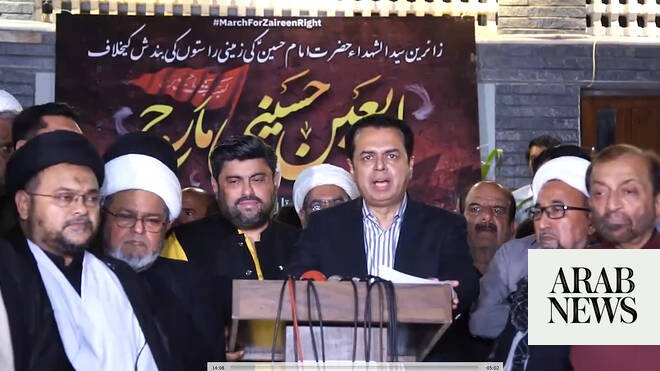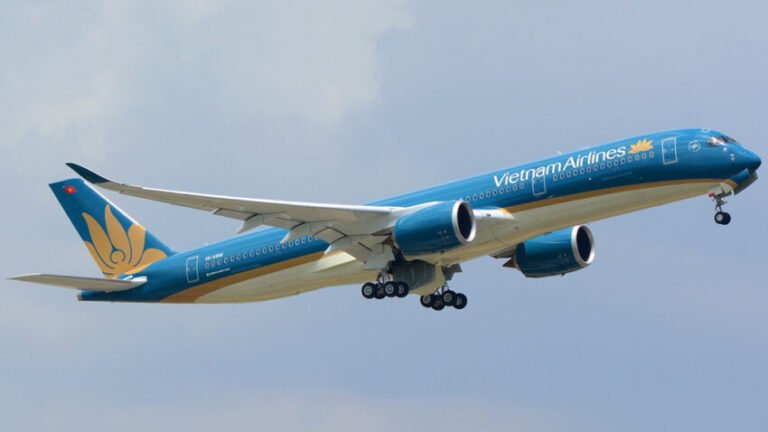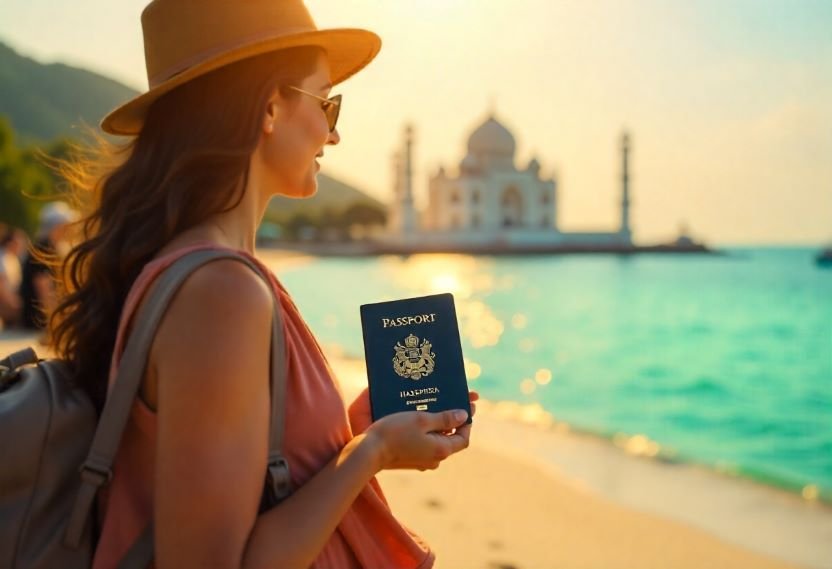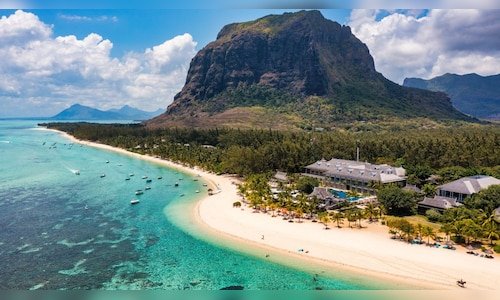Flight Buzz
Pakistan to arrange special flights, discounted travel to Iraq for pilgrims after land route closure

KARACHI: US President Donald Trump’s move to double tariffs on Indian goods presents a “strategic opening” for Islamabad to deepen its trade partnership with Washington, Pakistan’s finance adviser Khurram Schehzad said on Thursday.
Trump signed an executive order on Wednesday to place an additional 25 percent tariff on India on top of a 25 percent tariff that went into effect on Thursday. The move made India one of the most heavily taxed US trading partners in Asia.
Pakistan, India’s traditional arch-rival, has meanwhile improved its ties with Washington. Pakistan and the US finalized a trade agreement last week under which a 19 percent tariff was imposed on a wide range of Pakistani goods. The new rate marked a considerable reduction from the initially proposed 29 percent under a sweeping executive order signed by Trump.
“The US tariff hike on Indian goods presents a strategic opening for Pakistan,” Schehzad told Arab News.
Washington’s 19 percent tariff on Pakistani goods makes them less expensive than Indian goods, making Pakistan one of the countries with the lowest tariff profiles in the region.
“We see this as a moment of opportunity to deepen trade and economic ties with the United States,” the finance official added.
The US is Pakistan’s largest export destination, State Minister for Finance Bilal Azhar Kayani said on Thursday. He added that out of $32 billion of Pakistan’s exports in the last fiscal year, $6 billion went to the US.
Pakistan’s tariff deal with the US took place at a time when Islamabad is pushing for an economic revival, buoyed by a $7 billion financial bailout package by the International Monetary Fund (IMF).
Pakistan has undertaken financial reforms over the past two years. Prime Minister Shehbaz Sharif has tasked authorities to ensure Islamabad’s $32 billion annual exports surge to over $60 billion by fiscal year 2028-29.
Pakistan, having one of the lowest regional tariff profiles and also attracting a growing US investment interest, is positioned to expand its exports, particularly in textiles, pharmaceuticals, agriculture, technology, mining & minerals, and other value-added manufacturing, Schehzad said.
“This agreement will help us realize the long-term export targets we have set under Uraan Pakistan program,” he said, referring to the government’s economic plan that aims to make Pakistan a trillion-dollar economy by 2035.
‘MAJOR OBSTACLES’
Pakistani businesspersons, especially those related to textiles, think otherwise.
Atif Ikram Sheikh, president of the Federation of Pakistan Chamber of Commerce and Industry (FPCCI), said the US has imposed the lowest trade tariffs in the region on Pakistan, which Islamabad should take full advantage of.
However, he said higher production costs in Pakistan could neutralize this benefit.
“Taxes and high electricity and gas prices for the industry are major obstacles to taking advantage of low tariffs,” Sheikh said.
The textile industry is Pakistan’s biggest foreign exchange earner, fetching $18 billion during the last fiscal year, most of which came from the US.
Kamran Arshad, chairman of the All Pakistan Textile Mills Association (APTMA), was also unsure whether the new trade agreement with the US would benefit Pakistan significantly.
“The costly power and high interest rates would not allow us to compete (in the global textile market) at this 19 percent tariff,” Arshad told Arab News.
Last week, Pakistan’s central bank kept the policy rate unchanged at 11 percent, adopting a cautious approach.
According to the APTMA, Pakistan has a higher interest rate of 11 percent, compared to India’s 5.5 percent, Bangladesh’s 10 percent, Vietnam’s 4.5 percent, Sri Lanka’s 7.75 percent, Indonesia’s 5.25 percent and Cambodia’s 3 percent.
The power tariff for industries in Pakistan, meanwhile, stands at $0.16 kilowatt per hour as compared to $0.096 in India, $0.10 in Bangladesh, $0.08 in Vietnam, $0.06 in Sri Lanka, $0.07 in Indonesia and $0.135 in Cambodia, the data shows.
Pakistani businesses are paying 29 percent corporate income tax and as much as 10 percent super tax compared to the 27.5 percent preferential taxes their competitors from India, Bangladesh, Vietnam, Sri Lanka, Indonesia and Cambodia are paying on incomes.
“Pakistan’s corporate tax, policy rate, labor costs, electricity rate put us at a disadvantage with India, Bangladesh, Vietnam, Sri Lanka and Indonesia,” Arshad noted.
Shankar Talreja, head of research at Karachi-based brokerage firm Topline Securities, said the US is a “big market” for pharmaceuticals, textiles and food products.
“If Pakistan gets preferential treatment in the US market, this will help our companies grow further,” he said.
Flight Buzz
Vietnam Airlines Rolls Out New Inflight Wi-Fi On International Flights, Taking Travel Connectivity To New Heights

Published on
August 8, 2025 |
By: TTW News Desk
Vietnam Airlines has recently launched a pilot inflight Wi-Fi program on its Airbus A350-900 aircraft to significantly enhance the travel experience for passengers. With international flights, the airline modernizes its services, providing passengers uninterrupted internet access. The installation of modern satellite connectivity systems now allows passengers to browse, message, and work during the flight. Such improvements are essential for Vietnam Airlines to remain a competitor in the international travel market.
Vietnam Airlines Unveils Inflight Wi-Fi Pilot Program to Enhance Customer Experience
Vietnam Airlines has recently rolled out a pilot inflight Wi-Fi program, marking a significant step in enhancing the airline’s customer experience. As part of its ongoing commitment to modernizing travel, the carrier is providing internet access on its international flights, starting with the Airbus A350-900 aircraft equipped with advanced satellite connectivity systems.
The service, initially available on select international routes, allows passengers to stay connected while flying. Travelers can access the Wi-Fi through their personal devices and choose from a range of data packages tailored to various needs. Options include:
- Messaging Package: At just $5, passengers can enjoy unlimited text messaging across platforms, ensuring they stay in touch with friends, family, and colleagues.
- One-Hour Browsing Package: For $10, passengers can browse the internet for an hour, perfect for checking emails or catching up on news during the flight.
- Unlimited Browsing Package: For $20, passengers can access unlimited internet for the entire duration of their journey, enabling them to stream videos, browse the web, and stay connected throughout the flight.
While the Wi-Fi service is currently available only on international routes, the airline has expressed plans to expand it to domestic A350-900 flights in the future, promising broader connectivity for more passengers.
Business class passengers are enjoying a complimentary benefit during the trial phase. They can access the Wi-Fi service for free, providing an added layer of convenience for those traveling in premium cabins. Additionally, Vietnam Airlines is offering all passengers, regardless of cabin class, 15 minutes of free Wi-Fi to use messaging apps. This gesture aims to keep passengers connected without worrying about additional charges during the initial phase of the service.
The Wi-Fi service will be available on select Airbus A350-900 aircraft until December 2025, with further expansion planned for other planes within the Vietnam Airlines fleet. Currently, the airline operates 14 A350-900s, primarily used on long-haul routes, although they also frequently serve flights to Northeast Asia. As the program progresses, more planes in the fleet will be equipped with the necessary technology to offer the service to a wider range of passengers.
Vietnam Airlines’ fleet expansion has been marked by continuous efforts to improve the passenger experience. This Wi-Fi service is part of the airline’s broader strategy to enhance its offerings, making long flights more comfortable and productive for travelers. The new service comes shortly after the airline launched its inaugural nonstop flight from Hanoi to Milan, Italy, at the end of last month. This new route marks a milestone as the airline’s ninth direct European connection, continuing its expansion into international markets and providing more seamless travel options for both leisure and business passengers.
With the introduction of inflight Wi-Fi, Vietnam Airlines is aiming to align itself with global trends in the airline industry, where passengers increasingly expect connectivity during flights. The airline’s move to provide affordable and reliable internet access reflects a growing demand for seamless communication while traveling, allowing passengers to remain productive or entertained during their journeys.
For now, the service remains exclusive to Vietnam Airlines’ Airbus A350-900s, which are used for long-haul flights to destinations such as Japan, South Korea, and Australia. Passengers on these flights can look forward to an enhanced flying experience, where internet connectivity no longer needs to be a source of frustration.
Vietnam Airlines has also hinted at future improvements to its in-flight offerings, with plans to increase the number of aircraft with Wi-Fi capabilities. This means passengers can look forward to a more consistent experience across the airline’s expanding network of international and domestic flights.
As part of its broader strategy, Vietnam Airlines is committed to upgrading its fleet with the latest technologies, ensuring that passengers have a more comfortable and enjoyable experience from check-in to landing. With a strong focus on customer satisfaction and the growing importance of in-flight connectivity, the airline is poised to enhance its competitive edge in the international aviation market.
In the coming months, travelers on Vietnam Airlines can expect further developments in the airline’s in-flight service offerings, including the possibility of more data packages and an expanded Wi-Fi service network. As connectivity becomes an integral part of the modern travel experience, the airline’s decision to roll out inflight Wi-Fi is sure to make its long-haul flights even more appealing to tech-savvy travelers.
For those flying internationally with Vietnam Airlines in the near future, the inflight Wi-Fi program presents an exciting new option to stay connected while in the air, making the journey more enjoyable and efficient. Whether you’re checking emails, catching up on social media, or simply staying in touch with loved ones, the service promises to bring an added layer of convenience and comfort to your flight experience.
Vietnam Airlines has introduced a pilot inflight Wi-Fi program on its Airbus A350-900 aircraft to enhance the travel experience, providing passengers with seamless connectivity on international flights. This move aims to meet the growing demand for reliable internet access while flying, ensuring a more modern and convenient journey.
As Vietnam Airlines continues to innovate, passengers can expect more enhancements that contribute to a seamless, connected, and comfortable travel experience. With the continued rollout of its inflight Wi-Fi service, the airline is not only meeting the needs of today’s travelers but also positioning itself as a leader in providing cutting-edge amenities in the sky.
Flight Buzz
India-Philippines Tourism Strengthens with Free E-Visas and Direct Flights, Paving the Way for Seamless Travel

Published on
August 8, 2025 |
By: TTW News Desk
To strengthen tourism relations, the Philippines and India are significantly improving the travel connection between the two nations. With the issuance of free e-visas for Filipino tourists traveling to India and the launching of direct flights from Delhi to Manila in October of 2025, travelers will greatly benefit from the new opportunities offered for both parties. The aforementioned efforts will greatly improve tourism, ease travel, and open possibilities for business and cultural interactions between the two nations.
Visa Facilitation: A Game-Changer for Tourism
Starting June 8, 2025, Indian tourists will be allowed to visit the Philippines without the need for a visa, a policy the Philippines has recently announced. Indian tourists will be able to visit the Philippines for a maximum of 14 days without a visa. Additionally, holders of valid residence or tourist visas issued by the US, Japan, Australia, the UK, or some other countries have the option to extend their stay to 30 days. This policy increases Indian tourism to the Philippines which features stunning tourist destinations like Palawan, Boracay, and Manila, and also strengthens ties with a neighboring nation.
Furthermore, Philippines made equally bold moves to help India. E-visas will be issued free of charge to Filipinos traveling to India starting in 2025. The aim is to increase tourism from the Philippines to India’s culture, heritage sites, and cities like Delhi, Jaipur, and Mumbai. The structurally simplfied changes and removal of traditional visa application processes will likely lead to a significant increase in bilateral tourism between the two nations.
Such measures of visa ease for both nations are bound to encourage reciprocated travel and proactively foster notice tourism. This is a clear indicator that the two countries are forging a closer partnership that addresses the desire for development, reciprocal advantage, and overarching goals of travel and tourism between them.
Direct Flights: A Boost to Travel Connectivity
In a remarkable developmental update, Air India has announced direct flights between Manila and Delhi starting October 1, 2025. Travelers from both countries will now be able to engage in non-stop exploration of each other’s landscape or culture. Air India will greatly enhance travel between India and the Philippines by operating five flights a week.
Previously, visitors had to deal with connecting flights which added to the time and hassle of their journey. Now, with the new route, tourists and business travelers can make use of the direct flights that will be cutting down travel time. Whether it’s leisure travel to the beaches of the Philippines or business travel to India the new direct non-stop route will be beneficial for everyone.
Air India is positioning itself as the main operator of this new critical air corridor with the launch of these flights. This could also serve as a model for future direct international flights to better integrate India with other Southeast Asian countries.
Impact on Tourism: More Opportunities for Travelers
The introduction of direct flights along with the free e-visa policy is a combination that is likely to promote tourism between India and the Philippines. Filipino tourists will have better access to some of India’s world-famous tourist sites like Taj Mahal, Kerala’s backwaters, and the markets of Rajasthan. Likewise, Indian tourists will have easy access to the Philippines’ white-sand beaches, crystal-clear waters, and tropical paradise Islands like Cebu and Davao.
The seamless e-visa and direct flights also enable cultural exchange which is a powerful means of building understanding and relationship between countries. As a result, there will likely be a greater increase in not just leisure tourism, but also educational and cultural tourism. The two countries have a wealth of history and culture that travelers will be eager to explore.
Economic and Cultural Impact: A Shared Future
The impact reaches further than just tourism; it affects the economy and culture as well. The Philippines and India share strong and deepening business relationships in trade, technology, and education. Increased people-to-people travel will improve networking and collaborative opportunities. The tourism industry will reap the rewards of the enhanced travel, boosting investments in hospitality and tourism infrastructure in both countries.
This plan will especially benefit India’s hospitality sector. Increasing tourist flow from the Philippines will probably occupy the hotels in India’s major tourism hubs. These travelers will be looking for a variety of places to stay, from high-end hotels to more economical options. Also, there is an expanding Filipino market which will provide targeted advertising and tailored travel services, which means hotels and restaurants will be able to reach and meet the needs of this market.
This policy without a visa maximizes access for Indian visitors, many of whom travel for leisure or business. The resort industry will benefit as Indians increasingly seek exotic vacation destinations close to home. Furthermore, businesses in the Philippines from hospitality, retail, and food services will have more Indian travelers looking for unique experiences.
Technology’s Role in Facilitating Travel
Technology plays a vital role in supporting travel, and these policy modifications demonstrate this utility. The implementation of e-visas for tourists from the Philippines showcases a clear case of travel technology simplification. The e-visa system’s online application process coupled with fast approval makes it a secure and efficient method for managing global travel.
Moreover, technology is expected to help travelers with up-to-date information on flights, hotels, and other tourism services. Such tools will assist travelers from either country in meeting the required procedures and planning their trips effortlessly.
Conclusion
The issuance of free e-visas and the commencement of direct flights between India and the Philippines will significantly benefit the tourism industries of both nations. This will completely open the world of travel and enhance travel ease. From the tourism, hospitality, and airline industries, there will be an increased demand which will result in increased revenue and will give businesses the chance to expand their services and offerings.
Bilateral relations between the two countries are now 75 years old, and the two countries are hosting these initiatives to celebrate the relationship. This will serve as a catalyst for the two nations to further their relationship and the tourism industry. India and the Philippines are positioned to gain a lot once obstacles to travel are removed.
Flight Buzz
Independence Day 2025: ixigo launches Tricolour Travel Sale with up to 15% off on flights and hotels

As part of the promotional offer, customers can avail a flat 12 percent discount on flights and hotels by using the coupon code ‘FREEDOM’ while booking through ixigo. The offer does not require a minimum booking amount and is applicable across all modes of payment, with savings capped at Rs 1,000.
In addition, ixigo has partnered with ICICI Bank and AU Small Finance Bank to offer up to 15 percent discount (maximum Rs 5,000) on bookings made using their credit cards or via credit card EMI.
Also read | Andhra to start free bus travel for women from Aug 15; Haryana extends Raksha Bandhan gift
Aloke Bajpai, Group CEO of ixigo, said, “With August 15th falling on a Friday this year, many travellers are opting to take a day off on Thursday to make the most of a four-day weekend. We’re seeing that reflected in a significant uptick in flight bookings. Through our Tricolour Travel Sale, we’re making it easier for Indians to plan their perfect getaway without stretching their budgets. As value-driven travel becomes a growing preference, we’re enabling more people to explore both domestic and international destinations, without having to compromise on comfort or cost.”
The company has reported a 25 to 30 percent year-on-year increase in leisure flight bookings around the Independence Day period. Destinations such as Dehradun, Port Blair, Goa, and Coimbatore have emerged as top choices, reflecting a shift in traveller preference toward short, affordable getaways.
Also read | When is Janmashtami 2025 holiday, August 15 or 16? Know exact date, time and shubh muhurat
With rising interest in value-oriented travel and a favourable long weekend on the horizon, ixigo’s Tricolour Travel Sale is well-timed to meet the demand of Indian holidaymakers looking to make the most of their independence and time off.
(Edited by : Jerome Anthony)
-

 Brand Stories3 weeks ago
Brand Stories3 weeks agoBloom Hotels: A Modern Vision of Hospitality Redefining Travel
-

 Brand Stories2 weeks ago
Brand Stories2 weeks agoCheQin.ai sets a new standard for hotel booking with its AI capabilities: empowering travellers to bargain, choose the best, and book with clarity.
-

 Destinations & Things To Do3 weeks ago
Destinations & Things To Do3 weeks agoUntouched Destinations: Stunning Hidden Gems You Must Visit
-

 Destinations & Things To Do2 weeks ago
Destinations & Things To Do2 weeks agoThis Hidden Beach in India Glows at Night-But Only in One Secret Season
-

 AI in Travel3 weeks ago
AI in Travel3 weeks agoAI Travel Revolution: Must-Have Guide to the Best Experience
-

 Brand Stories1 month ago
Brand Stories1 month agoVoice AI Startup ElevenLabs Plans to Add Hubs Around the World
-

 Brand Stories4 weeks ago
Brand Stories4 weeks agoHow Elon Musk’s rogue Grok chatbot became a cautionary AI tale
-

 Brand Stories2 weeks ago
Brand Stories2 weeks agoContactless Hospitality: Why Remote Management Technology Is Key to Seamless Guest Experiences
-

 Asia Travel Pulse1 month ago
Asia Travel Pulse1 month agoLooking For Adventure In Asia? Here Are 7 Epic Destinations You Need To Experience At Least Once – Zee News
-

 AI in Travel1 month ago
AI in Travel1 month ago‘Will AI take my job?’ A trip to a Beijing fortune-telling bar to see what lies ahead | China

You must be logged in to post a comment Login